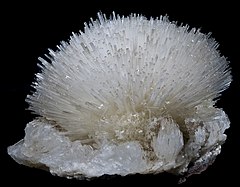Natrolite
| Natrolite | |
|---|---|

Natrolite
|
|
| General | |
| Category | Tectosilicate |
|
Formula (repeating unit) |
Na2Al2Si3O10·2H2O |
| Strunz classification | 9.GA.05 (10 ed) 8/J.21-10 (8 ed) |
| Dana classification | 77.01.05.01 |
| Crystal system | Orthorhombic |
| Crystal class | Pyramidal (mm2) H-M symbol: (mm2) |
| Space group | Fdd2 |
| Unit cell | a = 18.27, b = 18.587 c = 6.56 [Å], Z = 8 |
| Identification | |
| Formula mass | 380.22 g/mol |
| Color | White, colorless, sometimes pink |
| Crystal habit | Acicular |
| Twinning | On {110}, {011}, {031} |
| Cleavage | Perfect on {110} |
| Fracture | Irregular, uneven |
| Tenacity | Brittle |
| Mohs scale hardness | 5-6 |
| Luster | Vitreous, Silky, Pearly |
| Streak | White |
| Diaphaneity | Transparent to translucent |
| Specific gravity | 2.25 |
| References | |
Natrolite is a tectosilicate mineral species belonging to the zeolite group. It is a hydrated sodium and aluminium silicate with the formula Na2Al2Si3O10 · 2H2O. The type locality is Hohentwiel, Hegau, Germany.
It was named natrolite by Martin Heinrich Klaproth in 1803. The name is derived from νατρών natron, the Greek word for soda, in reference to the sodium content and λίθος lithos, meaning stone. Needle stone or needle-zeolite are other informal names, alluding to the common acicular habit of the crystals, which are often very slender and are aggregated in divergent tufts. The crystals are frequently epitaxial overgrowths of natrolite, mesolite, and gonnardite in various orders.
Larger crystals most commonly have the form of a square prism terminated by a low pyramid, the prism angle being nearly a right angle. The crystals are tetragonal in appearance, though actually orthorhombic. There are perfect cleavages parallel to the faces of the prism. The mineral also often occurs in compact fibrous aggregates, the fibers having a divergent or radial arrangement. Natrolite is readily distinguished from other fibrous zeolites by its optical characteristics.
Between crossed nicols the fibers extinguish parallel to their length, and they do not show an optic figure in convergent polarized light. Natrolite is usually white or colorless, but sometimes reddish or yellowish. The luster is vitreous, or, in finely fibrous specimens, silky.
...
Wikipedia
